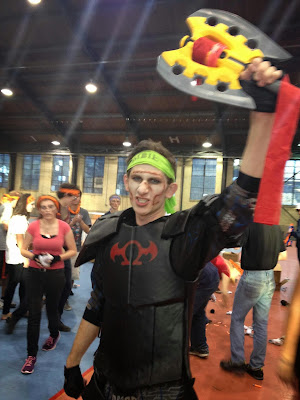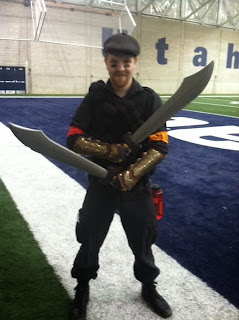 |
| The final battle ended decisively. The undead have taken over Utah State University. |
Rotting body parts, half-eaten organs and fetid entrails were strewn across Utah State University's desolate campus on Saturday.
The last human survivors had huddled together in the George Nelson Fieldhouse where, at 3 p.m., they make their final stand in a battle dubbed Herm's Deep.
“I do not plan on dying,” said human Leslie Bredthauer as scores of zombies surrounded the building. “I am going to fight as long as I can.”
Fight she did — as did her living brethren — with sock bombs and Nerf darts. But when the battle was over the zombie horde had assumed full control of the campus, exiling a small band of remaining humans from the once-bustling campus.
The undead had won the day.
•••
"The end of days"
Moments before the battle began, Cmdr. Steven "Sparkles" Collins addressed a group of about 20 humans, delivering a speech he'd composed on a blood-stained sheet of ruled notepaper — a reminder that he and his fellow warriors had been carefree undergraduates just days earlier.
"Humans. Survivors. Forth. Down fear the darkness," said Collins as he stood before the survivors. "Arise, arise, survivors of Utah State. Socks shall be hurled, blasters shall be exhausted. A stun day. A red day. Ere the sun rises. Fight now. Fight. Fight for ruin and the world’s ending. Death. Death.”
The speech brought cheers from the human army, which was gathered behind a structure its members had dubbed the Hornburg Wall.
Collins said he knew most of the remaining humans would lose their lives during the coming battle. He said he wanted to prepare them for that fate.
Joseph Lemmon understood the states.
“This is the end of days," Lemmon said as the zombies neared. "We will go out in a blaze of glory.”
As he prepared for battle, Eric Lambert said he would kill himself before letting a zombie infect him.
“I’m going to stand my ground and go down fighting,” Lambert said. “I will probably die today, but I will die human.”
Gathering behind a barricade, the humans awaited their end.
•••
"Just cannon fodder"
Approximately 70 soulless corpses shuffled forward, their mouths opened wide as their shrieks of hunger filled the air. The horde paused, momentarily, as Omega zombie Coltin Grover took a post before his undead army.
"Charge!" Grover screamed.
The zombie horde rushed forward, colliding with the human resistance. Blackened zombie teeth sunk into warm human flesh. Wave by wave, the zombies attacked. One by one, the humans fell.
As their numbers quickly dwindled, so too did the humans' morale. Warriors who just minutes earlier had cheered Collins' words were now screaming in desperation and agony.
In the midst of the chaos, Gen. Jon Kuhl lost track of the number of fellow humans killed.
“In the chaos, there’s no way to tell,” he said
Kuhl would soon be among the dead. Previously impervious to infections thanks to an antidote that wore off early Saturday, Kuhl reportedly stunned 28 zombies before succumbing to the horde.
“‘Tis but a scratch,” Kuhl said, before transforming into a blood-thirsty zombie.
Soon, his thoughts had turned toward human flesh. “I’m hungry,” he said.
Zombie James VanderMeyden said the said the undead strategy was to form two or three lines to charge the humans’ stronghold.
“The zombies in the front are just cannon fodder," VanderMeyden said. "They are there to block.”
The waves of attack granted the zombies time to re-spawn and fully recover from damages caused by the humans. The automatic re-spawning allowed the horde to become more powerful as the battle continued and many of the remaining humans became zombies.
The plan worked. Only 11 humans survived the initial zombie barrage. With dwindling troops and ammunition, the remaining mortals fell back further into their stronghold.
By the fifth zombie wave, human Zachary Jackson could see that his life was nearly over.
“On a scale of 1 to 10, I’m a 1," he said. "I know I’m going down.”
•••
"Avenge the fallen"
By 4:20 p.m., the battle was over.
Exiled alongside four other survivors, as the undead horde chanted and groaned in euphoria, Collins vowed to return with reinforcements.
“I plan to find all the humans I can to burn the horde and avenge the fallen who have died here today,” said Collins, who is thought to be immune from the zombie plague but did leave the site of the battle injured. “Mark my words, I will be back. I will raise an army. I will build whatever it takes and I will take the zombies down."
Emily Esplin, the executive vice president of the exiled Utah State University Students Association, issued a statement on behalf of the entire student body, and pledged to build a memorial on campus – once the zombie horde had moved on.
“Thank you to those who put their lives on the line to protect USU and its students,” she said. “I know that the losses are difficult to overcome, but as we've seen, good always overcomes evil.”
But Grover, the zombie leader, didn't see it that way.
Saturday's final victory, he said, was quite conclusive — and felt “pretty dang good.”
“The day of men is over and the age of the zombies has risen,” Grover said as he strolled through the rotting carnage of the battle. "Man has fallen. Man is weak. Man is dead.”
Though the war had come to an end, the stench of the zombie's victory lingered in the fall air.
UnDeadline reporters Sarah Winder, Mandi West, Lindsey Snyder, Taylor Condie, Ron Matheson, Dominic Bohne, Sierra Copeland, Jamie Keyes, Jaimie Son, Katie Larsen, Scott Hall, Caroline Peterson, Itzel Leon, Kris Hyde, Madison Maners, Stacey Worster, Stewart Ulrich, Hannah Hendricks, Alora Clark, Emily Lindley, Christopher Campbell, Bradley Bair, Marley McClune, Morgan Jacobsen, Eliza Welsh, Jeff Dahdah, Cassidy Stephens, Robyn Van Valkenburg, Mitch Watkins, Sara Bailey, Amanda Ahlman, Bennett Purser, Elisabeth Gee, William Christensen, Branson Smith and Mina Sayer contributed to this report.
















